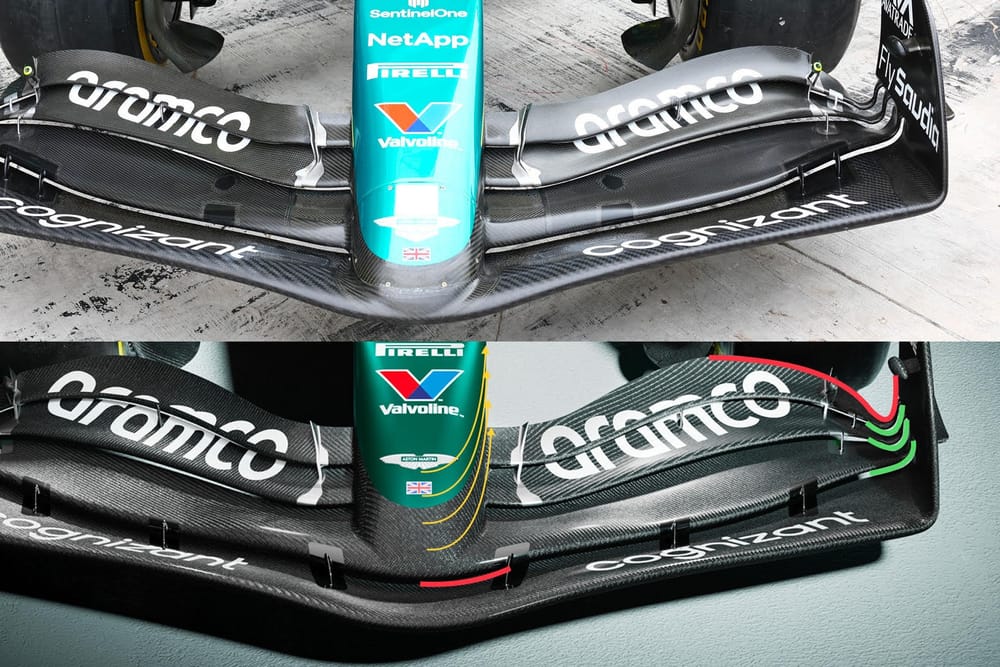Up Next

It will be tough for Aston Martin to repeat its surprisingly strong start to last season in 2024. It’s not impossible, but that hinges on whether it’s properly figured out why it fell away mid-season last year and never really recovered to the same level. In reality, where it ended up in the F1 pecking order last season should be what we compare it to for 2024.
McLaren should start in a better place and it wouldn’t surprise me if ‘Red Bull 2’ is in the top-10 mix as well.
However, Aston Martin has its new factory up and running, having moved in last year, and its expectations are high.
So let’s take a look at what we’ve seen so far, based on a combination of the launch render images and those from the Silverstone shakedown.
Just as the air flows over the car, I will start at the front and move rearward.
FRONT WING EVOLUTION

From this front view and in comparison to last year’s car below, we can see that Aston Martin has incorporated a slot gap (red highlight) between the front wing mainplane (forward element) and the underside of the nose.
This will allow it to have a more aggressive profile on the underside of the nose, which will generate better flow conditions to the central section of the underfloor.
It also has the more-rounded surface on the nose, allowing the airflow to come off the upper surface and around the sides with minimal effort.
It is this central area of flow that the diffuser mainly draws its airflow from, so anything that can be done at the front of the car will improve the performance further rearwards.

In this comparison, we can see there are some small detail changes to the outer end of the front wing (red highlight) where it joins the vertical endplate.
Also, there are modifications to the three slot gaps (green highlight) where the wing elements join the endplate.
These changes increase the front tyre outwash. Managing the flow around the front tyre is critical to the performance of the underfloor.
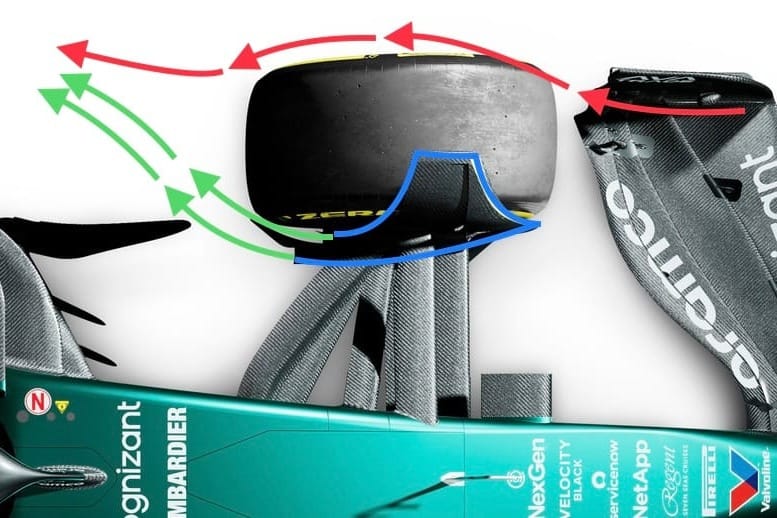
The inner mudguard assembly which incorporates the front brake duct (blue highlight) does a similar job on the inside. Low down on this inner mudguard, there are two turning vanes turning the flow into the low-pressure area just behind where the tyre leaves the track surface.
Behind the tyre, the outwash in front of the tyre (red arrow) and outwash behind the front tyre (green arrows) will blend into one. If this is efficient it will reduce the front-tyre wake and also the drag of the front-tyre assembly.
FRONT SUSPENSION STILL PUSHROD

From this front view, we can see that Aston Martin has retained the pushrod front suspension (red highlight) and has a reasonable amount of anti-dive on the upper-front wishbone (blue highlight).
The lower wishbone (yellow highlight) is fairly flat across the two inboard mountings, meaning that it doesn’t offer much-to-any anti-dive characteristics.
As with most other cars, the steering toe link is in line with the forward leg of the lower wishbone - so minimising the negative aerodynamic effect of having a separate component in the airstream.
MORE AGGRESSIVE RADIATOR INLET

The radiator intake has been the subject of a major revision. You could say it’s from the same family conceptually, but has matured quite a bit.
The inlet is now more or less just an opening in the top surface (red highlight above) and to manage the flow above it Aston Martin uses the rearview mirror and its horizontal mount (yellow highlight above).

In this side view, the flow over the sidepod (yellow arrow above) shows how the inlet is more or less in the top surface of the sidepod. The rad flow is the thicker magenta arrow. This is what would normally cool the car and the spillage when it happens is the thinner magenta arrow that follows over the top of the sidepod from the radiator opening.
The blue arrows represent the airflow that gets separated by the lower surface of the intake. This will be used to extract the flow from underneath the front corner of the floor represented by the green arrows.

Optimising this intake is critical to airflow structure consistency. When the radiator just can’t flow everything that is being presented to it, this excess flow represented by the magenta arrows above has to go somewhere.
With this style of inlet it will spill over the top surface and down the gully, again highlighted with the magenta arrows flowing into the lower-centre of the car, helping the diffuser when the car is at high speed and low ride height.
FLOOR CHANGES ARE SUBTLE
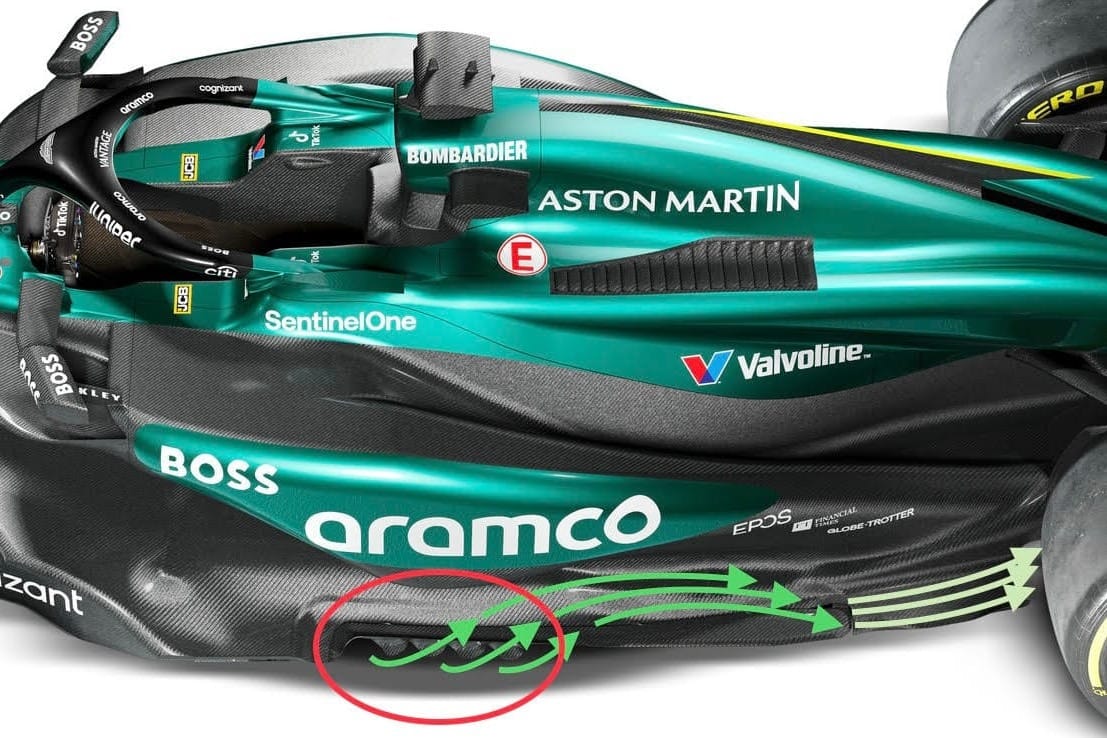
The floor edge detail is similar to last year, just a little more aggressive in that the forward vanes/splitters (red ellipse) are more pronounced.
This will have more effect on scavenging the front corner of the floor, which I have highlighted with green arrows.
This flow will then be pulled into this little duct, which connects it with what is known as the tyre squirt. This is the flow that is displaced by the tyre rotating onto the track surface and is quite powerful.
You could say it’s a bit like how the exhaust blowing worked - you are using this high-energy flow to scavenge that flow through that small tunnel, which helps seal the rear half of the floor with a sort of air cushion.
The lighter-green arrows represent that flow under the floor's surface.
AIR INTAKE LOOKS NEAR-IDENTICAL TO 2023

There is very little difference to the air intake to the turbo, and whatever the cooling ducts connect up to.
As this is the highest part of the car, optimising the weight of the rollover bar - which will help lower the car's centre of gravity while still meeting the test requirements - is probably more important than a major geometry change.
FOLLOWING MERCEDES' LEAD AT THE REAR
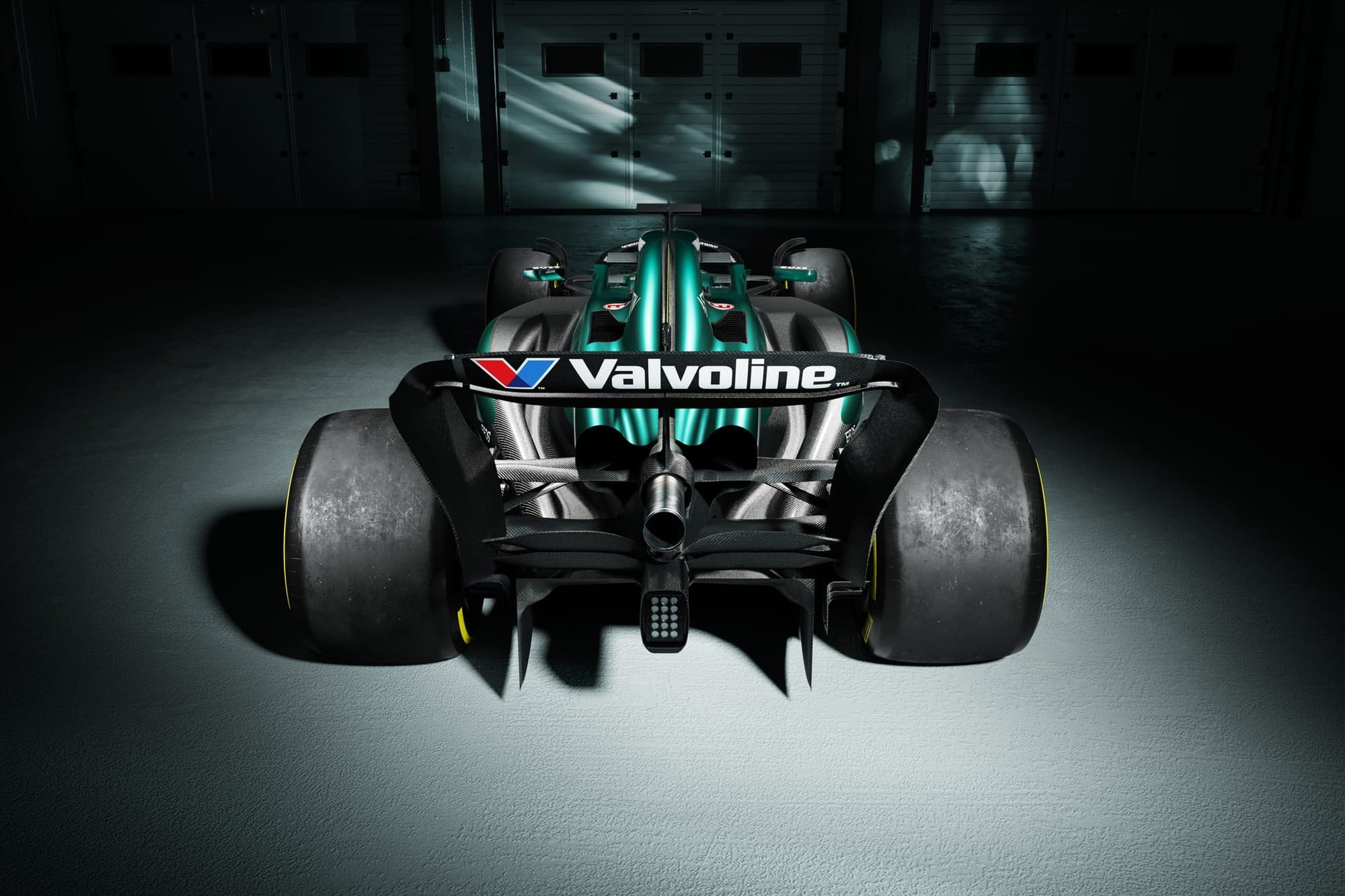
Aston Martin uses the Mercedes transmission system, which to some extent means Aston is tied into the Mercedes’ rear suspension points.
From there, Aston could use Mercedes suspension components or create different ones. For my comparison, and not to jump the gun on what Mercedes might introduce, I have assumed Aston has done its own thing.
It’s all fairly difficult to see in detail, but this is roughly what I believe to be the distribution of components.

The yellow highlight is the top wishbone.
The red highlight on the 2023 car is the pullrod. On the 2024 car it is the pushrod.
The magenta rectangle on the 2023 car was in effect the bottom wishbone, which was a sort of ‘A’ frame that also housed the driveshaft. On the 2024 car, the magenta rectangle still houses the driveshaft but is less of a wishbone.
The green rectangle on the 2023 car was the rear toe link. On the 2024 car it seems to have moved forward of the driveshaft.
The pushrod looks like it is at a very, very shallow angle to the lower wishbone, which is the component that reacts to a huge percentage of that pushrod load. This is perhaps why the lower wishbone and toe link look more equally displaced.
The top wishbone looks like it has a lower forward inboard pickup, meaning that it will reduce the lift on the rear of the car under braking.

In this picture, the top wishbone and the pushrod are easy enough to identify. However, the lower wishbone looks like a multitude of links so it could be quite different from a ‘normal’ wishbone layout. If anything in F1 is ever normal, that is...
CONCLUSION
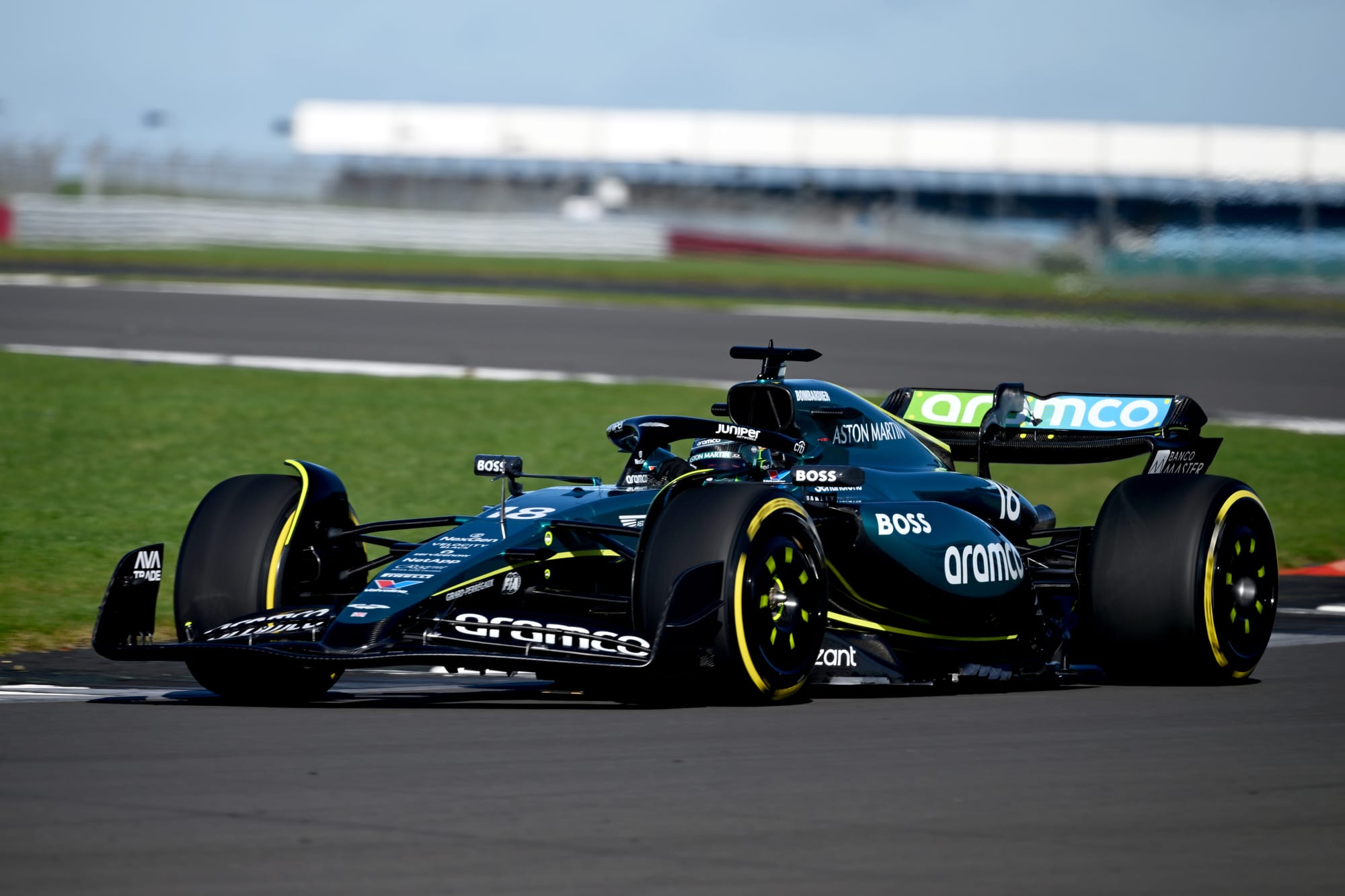
Overall, I’m impressed with the detail. It looks like a real step forward, but with these ground-effect cars it’s what happens on the track that counts, so it won’t be until we get to Bahrain before we or even Aston Martin know if it really is a step forward.
During the pre-launch interviews, Aston Martin technical director Dan Fallows referred to Red Bull as “absolutely beatable”, though when he was asked whether he meant in a championship fight or just in the odd race he toned it down slightly: “We talk about Red Bull because obviously they are the benchmark in terms of performance. But really for us, whoever’s the fastest car is the focus and that’s what we’re looking at.”
But after that, he explained something that I think is the most important part of any F1 car design - and if Aston Martin’s achieved it then its season ahead could be very bright.
“Rather than thinking about individual races, from an engineering point of view we have to make a car that is capable of operating at any circuit and being competitive, and that’s really what we’re focused on: making a car that’s usable, that’s good for the drivers,” said Fallows.
“That’s what we’ve really been trying to focus on. And those competitive stats and how we get closer to Red Bull will come after that.
“If we put our performance on the car then we give ourselves the ability to compete at that level, which is exactly what we want.”


